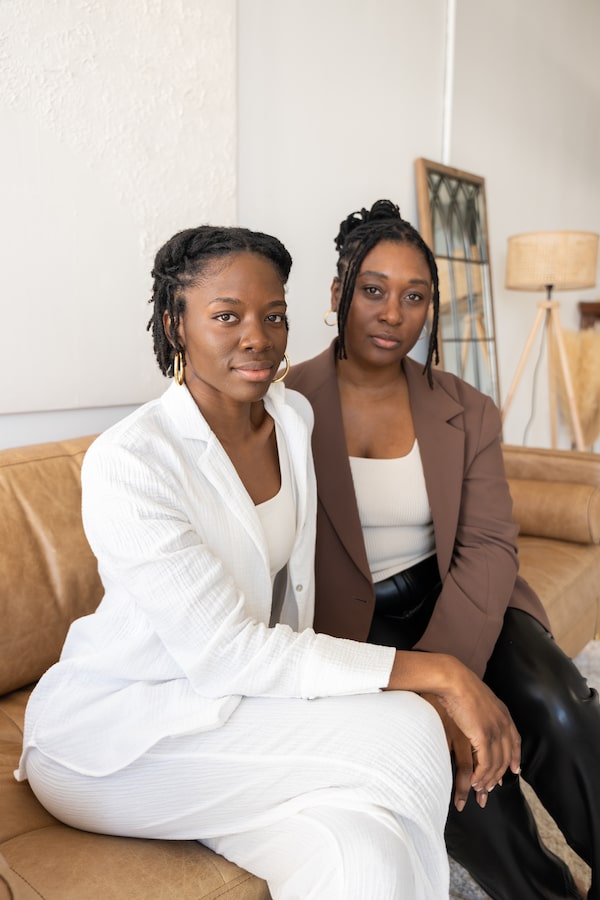Since Shanelle McKenzie and Kim Knight founded the Villij and started running pop-up wellness classes for racialized women in 2017, they’ve discovered they provide a lot more than simply a space to do yoga.
On last week’s opening day of their new Toronto studio – one of the first in Canada focused on this demographic but open to all women – they greeted everyone by name. And after the class’s many vinyasas (a sequence of positions) to the sounds of pranayama (deep breathing), instead of rushing out, most of the women stayed behind to talk to each other. In fact, those who go to the Villij’s classes often linger afterward, forming friendships that continue to flourish outside of the studio.
“So many women come alone and leave with their own village,” says Knight, who was born and raised in Montreal and has Jamaican roots. “They plan dinners, go bowling or even get their driver’s licenses together. This has changed how we see wellness.”

Kim Knight and Shanelle McKenzie, founders of The Villij.Supplied
The Villij is one of many initiatives across the country eliminating barriers to accessing self-care for Black, Indigenous and other women of minority groups. According to a survey from Canadian health benefits provider GreenShield, this demographic spends 31 per cent less time on self-care than their white counterparts. McKenzie and Knight say their own experience confirms this. A recent survey of their class participants revealed 60 per cent would have never tried yoga if they didn’t have access to the kind of space the Villij provides, where they feel safe.
While the term “safe space” has multiple definitions and contexts, what does it mean to create a comfortable place for people of all backgrounds to practise self-care?
McKenzie has some ideas. She remembers leaving her first yoga class as a young adult, thinking: “I’m never doing this again.” She was conscious of being the only Black person there, and at the end of her first class, the instructor began massaging her head without consent.
“This made me feel uncomfortable because hair is a sensitive topic in the Black community,” she says. This is why McKenzie gives women an option to indicate consent to being touched for support during the Villij’s yoga classes, using cards placed at the mats.
The Villij is one of many initiatives across the country eliminating barriers to accessing self-care for Black, Indigenous and other women of minority groups.Supplied
Shayla Stonechild, who is Nehiyaw Iskwew (Plains Cree) and the first Indigenous global yoga ambassador for Lululemon, was the only Indigenous person in the room when she started her teacher training in 2017 in Vancouver: “There was an Indigenous prayer, but it wasn’t led by an Indigenous person.”
That’s when she started to ask deeper questions about whether Western yoga, an industry estimated to be worth US$37-billion globally in 2019, is honouring its roots: “Who is leading from the lineage and from the land?”
In mainstream wellness spaces, BIPOC communities are generally less well-represented, a trend that is often mirrored in instructors. While yoga has been adapted in the Western world for its physical and mental benefits, the question of appropriation is not a new one, particularly as white faces are often at the forefront of wellness leadership (such as Gwyneth Paltrow) and rank the highest on YouTube. Leaders like Stonechild are working to bridge this gap.
This year, Stonechild’s non-profit Matriarch Movement held their first free in-person retreats, which incorporate Indigenous traditional teachings and dance with yoga and meditation, in Calgary, Vancouver and Toronto for racialized women and two-spirit people. Led by all-Indigenous wellness facilitators, the retreats carve out guidelines at the beginning, such as telling everyone to be mindful of the language they are using (gender pronouns, for example).
Shayla Stonechild, founder of Matriarch Movement, and the first Indigenous global yoga ambassador for Lululemon.Denita Gladeau/Supplied
“We do a sharing circle first, to understand where each person is at. We have an elder from the local region and territory say a prayer and smudge everyone, which sets the tone and creates a more emotionally safe space.” This acknowledgment is something many Indigenous women have never experienced within the wellness world, says Stonechild. “And sometimes it’s their first time feeling like they’re being heard in a space that was made for them.”
Stonechild says the cost of yoga excludes many from her community. “I got a scholarship and a loan to do my teacher training, which is usually around $5,000 each course. Otherwise I wouldn’t have been able to afford it.” According to Eventbrite, the average yogi in the U.S. spends approximately US$62,000 over their lifetime on yoga accessories, workshops and classes (which are often more than $30 each, or $200 to $300 a month for a membership).
For many, this would be a luxury, especially ethnic groups who face limited access to education, resources and financial opportunities owing to historical and continuing discrimination, says Biatris Lasu, founder of Ottawa-based Women of Colour Remake Wellness. Lasu’s organization runs a variety of wellness classes and outdoor group activities that are either free, donation-based or on a sliding scale, and offers assistance when individuals cannot afford to pay.
Increased financial support for BIPOC leadership could also help racialized people become better represented in the wellness space. The Villij founders are the first in their families to start a business at this scale, and it took years for them get where they are today.
While they received the BMO Celebrating Women Grant in 2020, they found it tough to secure funding over the years since criteria for grants often depends on particular assets: “You have to make a certain amount of money a year, have a certain number of employees, or already have a brick and mortar,” says McKenzie. Systemic factors could make it harder for Black women to own their own studios, as Black entrepreneurs are less likely to have access to financing and support in the form of networks and mentorship, according to a 2021 report from the Women Entrepreneurship Knowledge Hub.

Dr. Jessica Barudin is a Kwakwakaʼwakw scholar and community wellness practitioner.Cody Preston
Echoing this, Dr. Jessica Barudin, Kwakwakaʼwakw scholar and community wellness practitioner, says there are barriers to funding if you’re a grassroots initiative and not looking to create a conventional or big-box wellness business. Barudin organized the First Nations Women Yoga Initiative – training that prepares First Nations women and two-spirit people to offer yoga programs in their communities – as a central part of her doctoral research, which she completed in 2022.
Alongside an advisory of Indigenous women and trauma specialists, she created the 80-hour curriculum, bringing women in her community together to reclaim their ancestral language, healing practices and connection to their lands of the Pacific Northwest. This work has evolved into the Indigenous Yoga Collective, guided by an advisory circle of First Nations and South Asian women working to increase the representation of Indigenous yoga teachers in their own communities as well as in the wellness industry.

Indigenous Yoga Collective is working to increase the representation of Indigenous yoga teachers in their own communities as well as in the wellness industry.Supplied
“Our work is about holding spaces for women in our communities to have ways to fill their cups,” says Barudin. “It’s not just about providing feel-good moments. There’s a deeper meaning behind our vision where we’re offering body-based resources for Indigenous women to enhance their energy, tools and relationships, and also so they can engage in more equitable wellness practices that centre community care.”
While some corporate brands such as Lululemon have funding opportunities for BIPOC initiatives, Barudin says these are competitive and not everyone has the capacity to apply for grants, and sometimes it requires partnership with non-Indigenous institutions or organizations.
“We’re changemakers, mothers, entrepreneurs, researchers and community members who are all driven to reclaim our culture and language while being very involved in the well-being of our respective communities – so having more resources to do our work is essential,” says Barudin.
 Aruna Dutt
Aruna Dutt